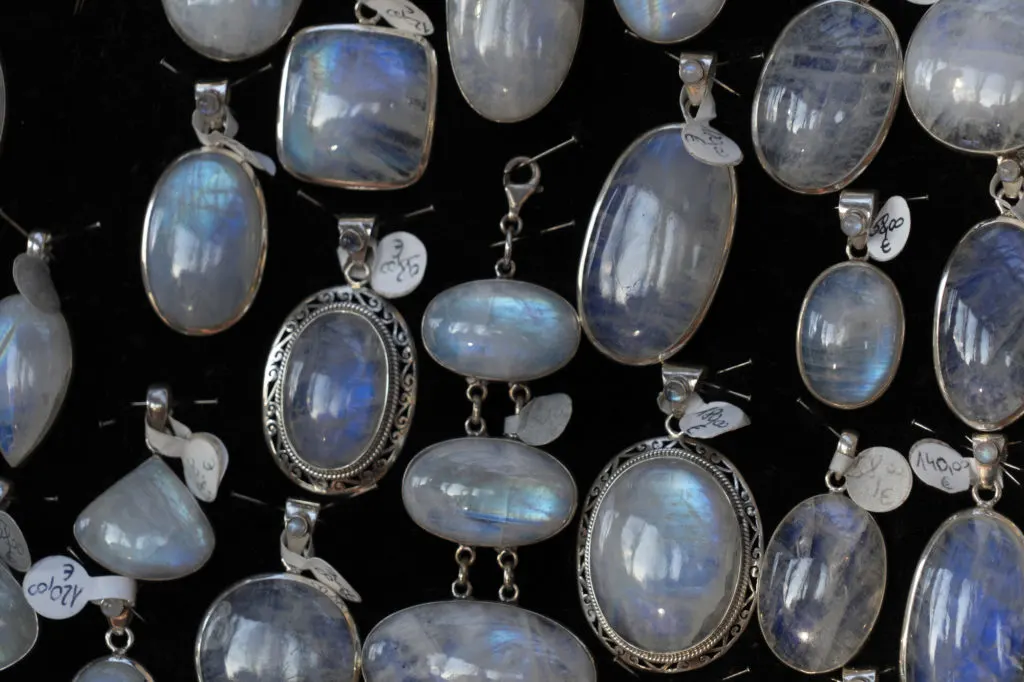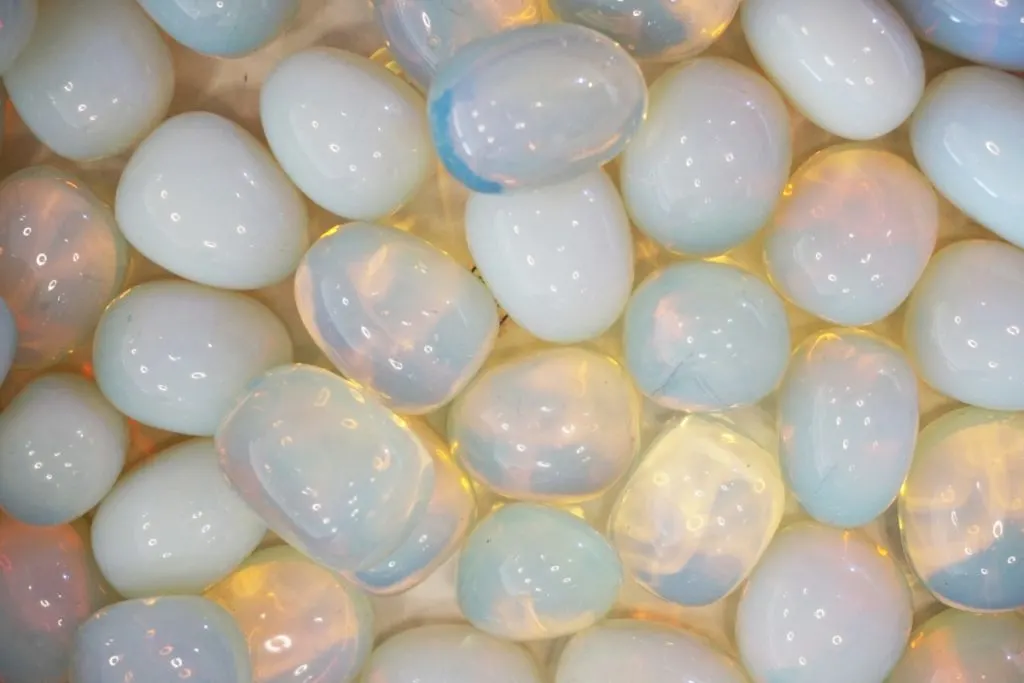As an Amazon Associate, I earn from qualifying purchases with no additional costs for you.
Moonstone is a sought-after gemstone due to its captivating blue sparkle and affordable cost. Despite its abundance, moonstone is at risk of high-quality fakes that are difficult to detect. Moonstones are so common that certain individuals have never encountered the real specimen, leading them to associate real moonstones with fake representations in their mental imagery.
Moonstone, a kind of feldspar, comprises oligoclase and albite crystals. Real moonstones typically possess a subtly layered structure that is barely noticeable due to their relative alignment. Fake moonstone exhibits no fractures or inclusions and seems completely uniform.
Distinguishing fake moonstones, which are frequently produced from a particular variety of glass called opalite, can first pose a challenge. Get ready for thorough analysis as we explore the hidden composition of real moonstones and acquire the ability to confidently identify fake ones by recognizing different characteristics.

If you want to check out the best moonstone rocks or jewelry, you can find them here (Amazon link).
How To Tell if Moonstone is Real?
Real moonstone is highly praised for its most captivating adularescence effect, blue and white-colored light that appears to billow across a gemstone.
Fake moonstone also has a similar phenomenon; however, we are here to give you a clue on recognizing the natural, mystically beautiful gemstone.
Real moonstone is a member of the feldspar mineral group. Real moonstone is an intergrowth of feldspar group members (albite and oligoclase). It has tiny parallel layers or fractures, which are sometimes intersected by other fractures perpendicularly. Real moonstone has fractures and inclusions.
Real moonstone is a member of the feldspar mineral group. The feldspars are the most common minerals in the Earth’s crust. They consist of three end-members:
- Orthoclase – KAlSi3O8
- Albite – NaAlSi3O8, and
- Anorthite – CaAl2Si2O8.
As a name for a gemstone variety, moonstone can be applied to any feldspar with adularescence. Commonly, moonstone is composed of two feldspar species: orthoclase and albite.
These two species are intermingled during crystallization. They form closely spaced layers that, due to the diffraction mechanism, scatter light rays in many directions, producing the adularescent phenomenon.
Adularescence makes the surface of a polished moonstone seem to glow with light blue and whitish colors, resembling Moonlight. Also, the produced misty light seems to roll across the cabochon surface during the motion.
Flawless, clear, or translucent gems exhibiting a rich blue sheen are considered the most valuable. Moonstones are typically cut as cabochons or carved to show off this effect. The finest moonstone gems come from Sri Lanka, Burma, Tanzania, and India.
What Does Real Moonstone Look Like?
Real moonstones, like any other gem, can slightly vary in appearance; however, to be called a moonstone, a gem must display a noticeable adularescence phenomenon.
Real moonstone body color can be green, yellow to brown, or grey to nearly black. The gemstone appears from semi-transparent to opaque, colorless to white, with a blue, silver, or white adularescent effect. Real moonstone usually has imperfections of parallel layers and fractures.
Real moonstones’ color range includes warm hues (yellow to brown) and cold hues (light green to blue and grey).
The finest real moonstones possess a colorless, semi-transparent, nearly transparent appearance and vivid blue adularescence, sometimes referred to in the trade as blue sheen.
It is commonly cut as a cabochon to fully display the moonstone’s adularescence. The other reason for the cabochon cut is the moonstone’s two cleavage directions, which make a gemstone more prone to breaking while faceting.
Real moonstone has very characteristic perpendicular fracture systems, which helps gemologists differentiate natural material from fake. Real moonstone, inner fissure systems, are situated along the cleavage directions of the mineral.
Such fissure systems are short pairs of cracks running parallel to the vertical axis of the crystal, with shorter cracks emanating perpendicularly along the length of the parallel fissures. These resemble many-legged insects under the microscope and are known as “centipedes.”

Moonstone is a relatively soft gem (6 and 6.5 on the Mohs scale). However, it is still harder than glass and opalite – the most common moonstone fakes.
Here are three main quality factors of real moonstone:
- Bodycolor. Moonstone body color should be nearly colorless and free of yellowish, brownish, or unattractive green tints.
- Sheen (adularescence) color. The sheen should be ideally blue.
- Sheen orientation. The sheen should be centered on the top of a cabochon and easily seen from a wide range of viewing angles.
TIP: Tumbled moonstones are even more beautiful than raw moonstones. Check out a step-by-step guide on how to tumble moonstone in the article below:
Can You Tumble Moonstone? Try These 4 Simple Steps
How to Identify a Real Moonstone?
A real moonstone typically exhibits defects as a characteristic feature. These qualities will assist you in distinguishing a real gem from a fake one.
The realness of a moonstone can be determined by its inherent imperfections. The identification of real moonstones can be improved by the multiple layers of oligoclase and albite minerals, which occur in a repeated pattern, and the presence of two intersecting fracture systems at right angles. Real moonstone does not include any circular air bubble inclusions.
A micro-layered structure formed through the repeating arrangement of feldspar crystals indicates a real moonstone.
When the moonstone is illuminated, the internal structure becomes visible, revealing its layered composition. The fake imitation of the moonstone exhibits an unclear and uniform appearance. There are no visible micro-layers.
Moonstone, a real gemstone, has a relatively low hardness rating of 6 – 6.5 on the Mohs scale, indicating its softness. Therefore, it is advisable to handle and wear it with caution. Nevertheless, while it is rather soft in wearability, it is still more durable than glass and any fake moonstones.
BTW: Do you want to know more about rock and mineral identification? The books listed below are the best ones you can find on the internet (Amazon links):
- Smithsonian Handbooks: Rocks & Minerals
- Gemstone & Crystal Properties (Quick Study Home)
- Ultimate Explorer Field Guide: Rocks and Minerals (National Geographic Kids)
How to Spot Fake Moonstone?
Fake moonstone is extremely widespread. It has an unusual and attractive appearance. Most probably, you already have one in your collection. It’s the best time to check your moonstone!
The fake moonstone looks too perfect. It doesn’t have any inclusions or fractures and looks sterile and homogeneous. Sometimes, fake moonstones made of glass have round air bubbles, which cannot be observed in a real gemstone. Fake moonstone looks semi-transparent and milky. Some fakes are warm to the touch.
An opalite is the most common fake of moonstone and opal. Opalite is not a natural mineral and has no relation to opal, moonstone, or quartz. Opalite is a man-made glass.
It is clear, meaning no inclusions and no micro-layered structure. Sometimes, tiny bubbles can be captured within the opalite glass, while no bubbles are inside the natural moonstone.
Also, fake moonstones can be spotted due to their milky glass appearance.

Recently, natural moonstones were spotted impregnated by artificial materials. They can also be considered fakes, especially if no proper disclosure of their enhancement exists. UV light can come in handy while spotting this kind of fake. Artificial filler glows under UV light.
TIP: You know the difference between real and fake moonstones now. Do you know how valuable the real moonstone can be? Find out more about the value of moonstones in the article below:
GUIDE: Rockhounding with UV Light & 3 Best UV Lights (2021)
Real vs. Fake Moonstone: The Main Differences
Fake moonstone can be represented by opalite synthetic glass, plastic, and impregnated natural material.
Here is a general table with differences between a real and fake moonstone. Please make sure to check all the characteristics before buying a moonstone.
| Material characteristic | Real moonstone | Fake moonstone |
|---|---|---|
| Micro-layered structure | Warm to the touch in the case of plastic-made fakes.Cold to the touch in the case of glass or opalite fakes, but for the first second only. | No layers. Fake stone looks even and homogeneous. |
| Touch test | Cold to the touch for a few seconds. | Different sheen colors can be observed in one stone: yellow to blue. |
| The color of adularescence | Only one color is observed on the gemstone surface, either blue or white. | Sometimes, it can be observed in opalite fake moonstones. |
| Hardness | 6 – 6.5 on the Mohs scale | 5 for glass or opalite3-4 for plastic-made fakes |
| Fracture systems | Tiny fractures can be observed. Two fracture systems intersect each other under a right angle. | No fractures can be observed. |
| Presence of air bubbles | Absent. | It can be inert or glow blue or orange color. Luminescence is evenly distributed on the mineral surface. |
| Price and visual clarity combination | High price (more than a hundred dollars) for an eye-clean gemstone. | Low price ($5-20) for transparent and inclusion-free stones. |
| UV light test | Can be inert or glow blue or orange color. Luminescence is evenly distributed on the mineral surface. | Impregnated fake moonstones will glow under UV light unevenly. |
TIP: You know the difference between real and fake moonstones now. Do you know how valuable the real moonstone can be? Find out more about the value of moonstones in the article below:
Are Moonstones Valuable Rocks? The Real Worth of Moonstones
Conclusion
The moonstone is a quite common mineral with very high-quality and hard-to-spot fakes. Opalite (man-made glass) is the most widespread fake of moonstone. Please pay attention to the next 8 differences to identify if the moonstone in front of you is real or fake:
- Micro-layered structure for real moonstones.
- Touch test. The real moonstone is cold to the touch.
- The color of adularescence. Only one color (blue or white) for real moonstone.
- Hardness. Real moonstone hardness is greater than that of glass and fakes.
- Fracture systems. Fractures intersect under a right angle in the case of real moonstones.
- The presence of air bubbles is a characteristic of fake.
- Price and visual clarity combination. Transparent and free from any inclusion of cheap moonstone – is a sign of a fake.
- UV light test. Fake-impregnated moonstone glows unevenly.
TIP: You already know how valuable the moonstones can be, but do you know where to find them or how they are formed? Check out the articles below and find out more:
How and Where to Find Moonstone? The Ultimate Guide
What Is Moonstone And How Is It Formed? Here Is the Answer
